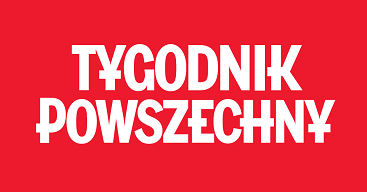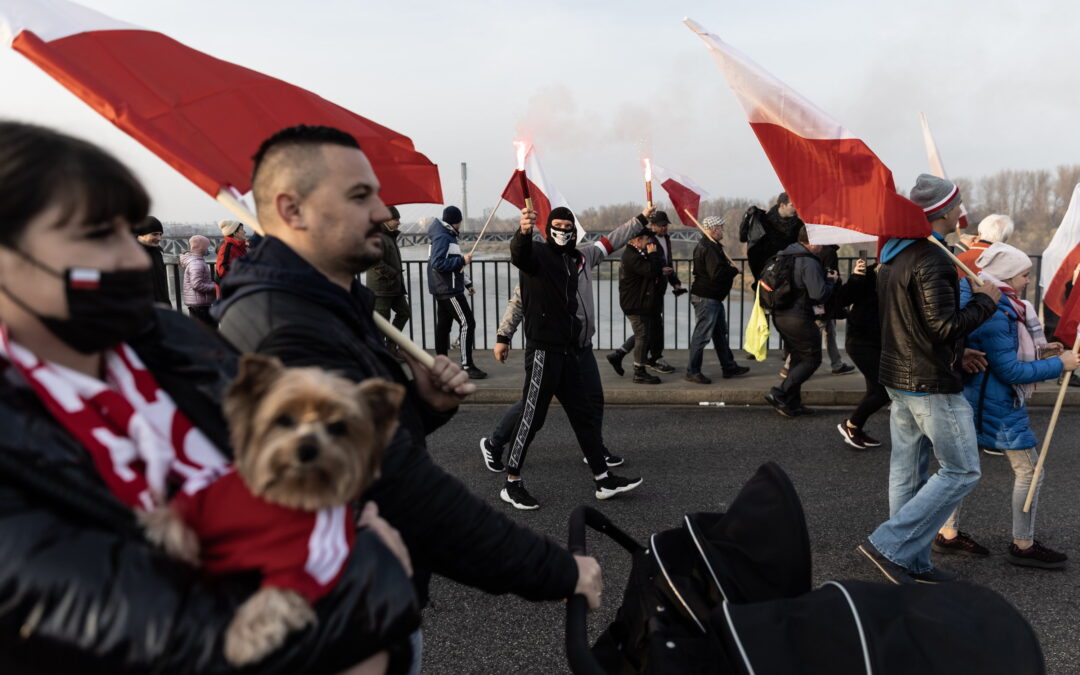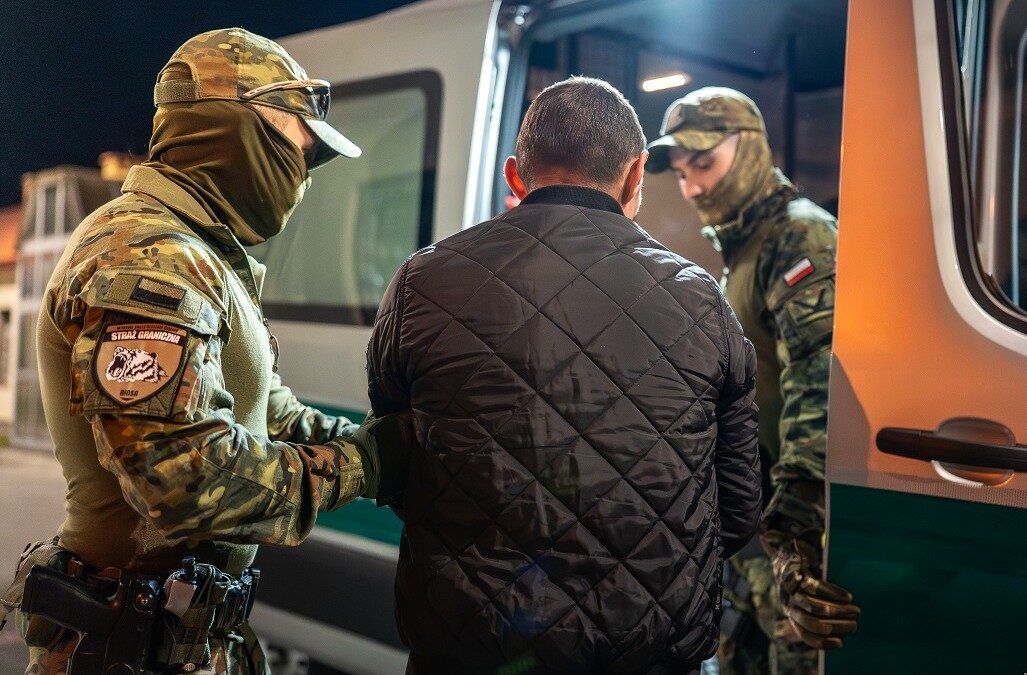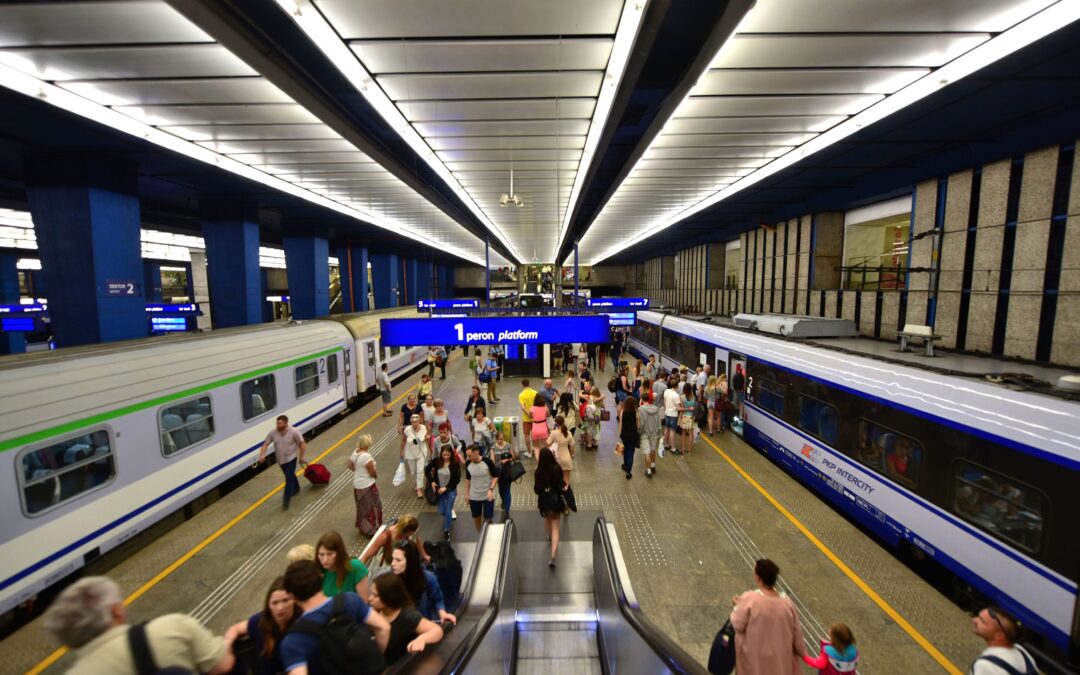In this interview (originally published in Tygodnik Powszechny), Agnieszka Pasieka, a researcher at the University of Vienna, discusses how Polish nationalism is far more varied than outsiders often appreciate, and how it fits into the broader spectrum of European nationalisms.
She speaks in particular about the annual Independence March in Warsaw on 11 November. Though the event, which draws tens of thousands of people, is organised by three far-right groups – with Robert Bąkiewicz, former leader of National Radical Camp (ONR), as the main organiser – it draws a much wider range of participants, from mainstream conservatives to neo-fascists.
Maciej Müller: Is the front of the Independence March – led by Robert Bąkiewicz – representative of Polish nationalism? Or do we just see the curiosities of one faction there?
Agnieszka Pasieka: The march was the product of the activity of one wing of the nationalist movement, but with time it has become a varied event meeting the needs of diverse groups. We could say a lot about them (including the legendary “families with children” [a term often used by defenders of the march to say that it is a peaceful, family-friendly event]).
But the most important thing is that they include both those who are pleased with the support of Law and Justice (PiS) [Poland’s national-conservative ruling party] and the antisemitic faction that treats PiS like any other political party.
My colleague Grzegorz Krzywiec, a researcher of fascism, wrote that the decision to give the march the status of a state event [made by the government this year to ensure it went ahead after courts effectively banned it] was like the dragon eating St George. I just wonder which is which in the relationship between the state and the nationalists.
I think that even among the nationalists themselves there is no agreement – some are happy with the government’s support, while others will say that the government took their march away. “I’d rather a Marxist bullet than a right-wing pat on the back,” one activist told me with a smile during the 2018 march, quoting the leader of the Spanish Falange, José Antonio Primo de Rivera.
But this march sets the tone for the media description of nationalism in Poland.
I couldn’t be in Warsaw this year and so followed the media reports. I was shocked that in what was supposed to be a record of facts I couldn’t find information, for example, about whether the march was dominated by older or younger people. Instead, there was ridicule of the “patriotic style” or people praying on the route.
I was equally surprised that the entire community was equated with the National Radical Camp, although the nationalist movement today is a whole spectrum of organisations and activists that are often much more present in Poland’s political life than the ONR.
What about the poster promoting the event this year, stylised as a Nazi announcement [suggesting that Warsaw’s liberal mayor is a representative of German occupiers]?
That is an example of one of the extremes, but also one of the voices in the nationalist movement. As a researcher of minorities and as a human, I don’t want to diminish the significance of xenophobic slogans or violence. But for many years I’ve felt that the “problem with the march” is largely aesthetic and class based. The media are offended by its “folk” nature. They report the extremes, saying hardly anything about the ordinary participants. Why? Because the march serves to expiate the rest of society: everyone who did not take part is tolerant, open to diversity, egalitarian…
We therefore escape having to admit that the marchers are pupils of Polish schools (not necessarily from the PiS era), students of Polish universities, raised in Polish families. We will not understand the phenomenon and attractiveness of nationalism if we do not realise that our daily lives are imbued with nationalism, including the press which is so critical of the nationalists.
The relationship between the “nationalism on steroids” the march represents and “everyday nationalism” is much closer than we think.
The far-right Independence March on Thurs has an official poster of the event with the main element being Nazi-styled announcement saying displays of patriotism like flags will be "severely punished."
Signed, ofc, "Tschaskovsky", quasi-German rendering of Warsaw's mayor's name. pic.twitter.com/3uqX7zwdlB
— Wojciech Kość (@WojciechKosc) November 10, 2021
Previously, this year’s march had been promoted only by a graphic showing two people whose faces we don’t see shaking hands, with sashes on their sleeves in the colour of the Polish flag, and the slogan “Independence not for sale”.
That is an example of a narrative that doesn’t want to shock. In previous years, some posters were full of apocalyptic contents, e.g. in 2017 there was an archangel, hellfire, sky, crosses… But in others there were ordinary people depicted. On one of the posters from 2020 there is a female student, a girl in a leather jacket, a man who could work in a bank or school, with the slogan: “Our civilisation, our rules.” Nationalism is presented as ordinariness, the social mainstream. But the future is at stake, so a child is included.
Is it not about saying “we have our rules, and we will defend them”?
Rather “we say how it should be”. If you want to live here, accept our rules. In the National Rally in France there are Muslim activists, and that’s not as paradoxical as it might seem. Because the party’s narrative is civilisational: we admit you to the community as long as you will accept certain rules.
A few years ago, an ONR activist used the term “racial separatism”. Many activists immediately distanced themselves from him and dissociated themselves from racism. A few months later, I took part in a meeting of the movement: they debated for a long time how the concept of nation should be understood today. When we look from outside, it might seem that nationalist circles are constant monoliths, but they perpetually redefine themselves.
Many older-generation nationalists defined Polishness by the “blood and soil” rule. For younger ones it’s clear that you don’t have to be born a Pole; you can become one. So I always say that there’s no such thing as a “typical nationalist activist” today; the contemporary Polish nationalist scene is divided between a vision of nationalised socialism and a neoliberal economic model, between a vision of the organisation as a community and party activity, as well as between various visions of Polishness.
In France a Muslim can be a nationalist. But in Poland, the phrase “Catholic Pole” still operates.
The ONR statute in the past stressed that members of the organisation had to be Catholic, but the activists now say that they must “respect Catholic tradition”. That is a clear shift towards understanding religion as cultural heritage. A nationalist can be an atheist or follower of another religion as long as they respect Catholicism.
The nationalists very much appreciate the Polish Tatars [a centuries-old Muslim community], for example, seeing them as a model, assimilated minority. They are ethnically foreign, celebrating their own traditional and faith, but they don’t want autonomy – they feel Polish. Of course, there are few such “others”, as Poland is a very homogeneous country both ethnically and religiously. We can see, however, that Polish nationalists are “flirting” with the concept of a civic notion of the nation. That is the only way to attract people who are not Catholics or ethnic Poles.
Can nationalism be civic?
The division into ethnic nationalism, emphasising the community of origin, and civic nationalism, based on the idea of a social contract, often suggests that the latter model is rational, liberal, based on the idea of human rights. This division has been criticised as one of many narratives contrasting the “backward East” with the “modern West”. The way that nationalist movements are starting to use the idea of civic nationalism shows how malleable this concept is and that it doesn’t have to be “liberal”.
The civic nationalism that nationalist movements are beginning to promote promises inclusivity, but by their own rules. We will accept a Ukrainian who has settled here and pays taxes, but on condition that he will agree to “our civilisation, our rules”. A few years ago, Polish and Italian activists told me that if I wanted to understand what is going on in European nationalist movements I must go to Hungary.
So I went to a Hungarian folk music festival organised by nationalists. I remember that an ONR leader pointed out two people as a kind of ideal. One muscular and tattooed, looking like a stereotypical football fan, embracing a guy with dreadlocks who was only missing a Che Guevara T-shirt.
The ONR activist thought that the success of the Hungarian nationalists was about managing to unite very diverse groups around the national idea. He added that the key to success is not the number of people marching on 11 November, but various groups of people believing that the nationalists are not extremists and have common-sense views.
Common sense?
The intensification of nationalist attitudes in Poland occurred in a period of mass migration to the West. Thousands of people decided that they’d earn more washing dishes in London than at home, where the employers only offer them junk contracts. Civic Platform (PO), in government at the time, presented emigration as an opportunity to the young generation. One ONR activist told me then: rather than the message “you can leave”, I’d rather hear “you can stay”.
The nationalists turned the government narrative on its head: for them, it was not mobility, but immobility that was a privilege – the chance to find decent work and a place for yourself at home, even if you lived in a small town. Since that attitude was ridiculed as parochial and anti-European, many young people began to sympathise with nationalist organisations, where they felt understood and appreciated.
What kind of people become nationalist activists?
Nationalists include lawyers, biotechnologists, shop assistants and security guards, not to mention students – they always set the tone. In spite of appearances, it is hard to find one common biographical factor.
When I started researching Italian nationalists, I expected that I’d find there for example people whose grandfathers were active in the fascist movement and had been told since childhood how good it was under Mussolini. Yet there are also children of the ’68 hippie generation. So joining the nationalists can result both from continuation of family tradition and from rebellion against it. A certain common denominator is the need for action and community.
What about relations with the government?
In Poland, there was a significant decline in interest in the nationalist movement when PiS came to power. Nationalism lost the taste of forbidden fruit then. One ONR activist even told me, “Perhaps we even have a few too many of those Cursed Soldiers [postwar anti-communist partisans] roundabouts now. There’s no need to fight to restore their memory any more – we need to find a new narrative, new goals.”
“The Other” used to be Jews or Germans. Is it LGBT activists or Muslims now?
No. Public enemy number one is “the Westerner” – an individualistic advocate of liberalism, consumerism and cosmopolitanism, “damaged by abandoning the community”. One Polish activist told me, “I realised how wrong we were. It’s not immigrants who are our enemy, we actually need more of them. They uphold values, believe in family, respect religion.”
So, for example, a Syrian attached to his identity becomes a point of reference to nationalists – by observing immigrants they can reinforce their identity. In Italy and Hungary, I often heard the story: “I grew up in a district where there were lots of Moroccans/Roma. Why do they manage to cultivate their own culture but we see our traditions as unfashionable?” Although Hungarian nationalist groups see the Roma as a social threat, they respect them for keeping to their cultural roots.
I don’t think nationalists will soon be carrying banners inviting immigrants to Poland – but the attitude towards them is changing.
Polish nationalists invite members of the Italian Forza Nuova to their marches and celebrate the electoral successes of the AfD in Germany. Should nationalisms from various countries not repel each other?
Nowadays it is stressed that Facebook has allowed nationalists from various countries to begin to talk and work together. But even in 1934, when the Polish minister Bronisław Pieracki was shot by the Ukrainian nationalist Hryhorij Maciejko, he was able to flee to the Balkans thanks to a network of collaborators – nationalists from Czechoslovakia and Bosnia. Before the war, Romanian nationalists invited Polish nationalists to summer training camps, and similarly Italian fascists hosted the Croatian Ustaše.
So nationalists from various countries see each other as allies. It is not Germans or Italians who are the enemy, but the rotten, cosmopolitan culture of the West that must be repaired. How? By rebuilding strong national communities that should work together, but differently from how they do in the European Union. I wouldn’t call it an anti-EU mood, though, but rather “alter-EU”. Nationalists don’t want to question Europe, but to realign it.
So cooperation, but with strictly marked borders?
Separate “cultures” should remain separate. But the culture of the West wants to mix everything up: women with men, the Poles with the French. When I participated in an Oktoberfest organised by Italian nationalists in Florence (an interesting example of the perception of another culture and its influence, incidentally), one activist asked if I’d been to the ethnographic museum – because without that I wouldn’t understand what nationalism was.
We went. There was a wall where traditional exhibits from ethnographic expeditions were displayed: faces of an African Pygmy, an inhabitant of Siberia, an Australian Aborigine etc., and at the end a mirror. The meaning was clear – we are an element of a diverse world. My interlocutor explained: “Diversity must be respected. We can’t mix. Zoologists weep when a species of wolf dies out, but nobody cares when cultures vanish.”
Are borders the foundation?
Yes, nationalists are attached to the idea of borders because they prevent mixing of “cultures”. And international relations and cooperations will be made possible because every nation will be firmly rooted in its own identity.
Of course, that picture is complicated by reality, and nationalists don’t agree on many levels. For example, the Italians criticise the German AfD for excessive liberalism or defending LGBT rights. The Poles can’t understand how the Italians can work together with German groups that have not renounced the legacy of Nazism. The Hungarians don’t like the fact that the Poles collaborate with the Slovaks who they have been in conflict with for a long time (a large Hungarian minority lives in Slovakia).
Nationalism today responds to the need for community and social solidarity better than any other ideology. Nationalists therefore claim to be speaking in the name of the victims of globalisation, because nobody else does that; and they do that at a global level, as transnational nationalists. They stress that they want a strong social state, investments in public services, transport, local shops, and not the dictate of Amazon.
That sounds pretty left-wing…
In the liberal PO-PiS consensus there was no room for such topics as workers’ rights, trash contracts, housing or the power of global corporations. The extreme right entered that field and grabbed from socialist tradition with both hands. Yes, if not for the nationalist background, such ideas could easily be supported by part of the left. I’m sure that the surprising points of contact in the programmes of the radical right and radical left will shape policy in the coming years.
The original version of this interview can be seen here. Translated by Ben Koschalka

Main image credit: Martyna Niecko / Agencja Wyborcza.pl, Author photo by Adam Musiał






















